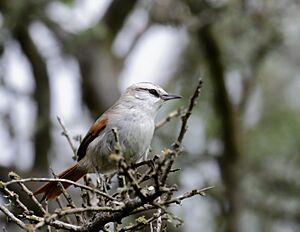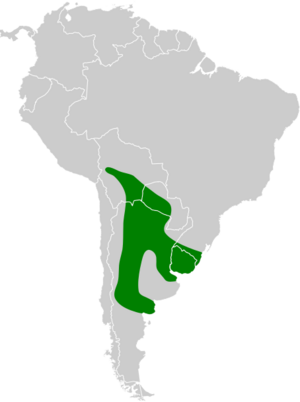Stripe-crowned spinetail facts for kids
Quick facts for kids Stripe-crowned spinetail |
|
|---|---|
 |
|
| Conservation status | |
| Scientific classification | |
| Genus: |
Cranioleuca
|
| Species: |
pyrrhophia
|
 |
|
The stripe-crowned spinetail (Cranioleuca pyrrhophia) is a type of bird that belongs to the ovenbird family called Furnariidae. You can find this bird in several South American countries, including Argentina, Bolivia, Brazil, Paraguay, and Uruguay.
Contents
About the Stripe-crowned Spinetail
What Are Its Different Types?
The stripe-crowned spinetail has three main types, which scientists call subspecies. They are:
- C. p. pyrrhophia
- C. p. rufipennis
- C. p. striaticeps
Scientists study the genes of these birds to understand how they are related. Research shows that the stripe-crowned spinetail is very closely related to the pallid spinetail. They are like "sister species." It also has close ties to the olive spinetail. Sometimes, the stripe-crowned and olive spinetails even breed together in southern Brazil.
How to Identify This Bird?
The stripe-crowned spinetail is a small bird. It is about 13 to 16 centimeters (5 to 6 inches) long. It weighs between 10 and 16 grams (0.35 to 0.56 ounces). It has special patterns on its head (crown) and tail that make it unique. Both male and female birds look the same.
Adult birds of the most common type (C. p. pyrrhophia) have a wide white stripe above their eyes. They have dark brown areas around their eyes. Their head is striped with blackish and buffy brown colors. These stripes can be lighter in some areas like southern Brazil and Paraguay.
Their back is grayish-brown, and their lower back and upper tail feathers are a browner color. Their tail feathers are pointed and look a bit forked. The middle tail feathers are dark brown or reddish-brown. The outer tail feathers are reddish-brown. Their wings are mostly reddish-brown and dull brownish.
The throat of the bird is whitish. Its chest is brownish-gray or buffy-gray, and its belly is a darker gray. The chest and belly can be lighter in southern Bolivia. Their eyes can be dark red, pale orange, or dark brown. Their beak is usually dark at the top and pinkish at the bottom. Their legs and feet are olive-green or yellowish-brown.
Younger birds (juveniles) have a head that is not striped. Their underside is darker than adult birds and might have faint spots.
Differences in Subspecies
- The C. p. striaticeps subspecies has more stripes on its head. Its back is a bit browner, and its upper tail feathers are more reddish. Its chest and belly are paler and less gray.
- The C. p. rufipennis subspecies has head stripes that are in between the other two types. Its back is even browner than striaticeps. It also has more reddish colors on some of its wing feathers.
Where Does It Live?
The stripe-crowned spinetail lives in different parts of South America.
- The most common subspecies, C. p. pyrrhophia, lives in southern Bolivia, western Paraguay, and central Argentina. It also lives in almost all of Uruguay and Brazil's southernmost state, Rio Grande do Sul.
- C. p. rufipennis is found in the Andes mountains in Bolivia, specifically in the La Paz and Cochabamba areas.
- C. p. striaticeps lives in the central and southern Andes of Bolivia, in the Cochabamba, Santa Cruz, and Tarija areas.
This bird can live in many different places. These include tropical forests where trees lose their leaves, forests along rivers, dry mountain areas with shrubs, and dry grasslands. In the Andes mountains, it lives in woodlands with Alnus and Podocarpus trees. It can be found from sea level up to about 3,100 meters (10,000 feet) high.
How Does It Live?
Movement and Migration
The stripe-crowned spinetail stays in the same area all year round. It does not migrate.
What Does It Eat?
The stripe-crowned spinetail eats arthropods, which are small creatures like insects and spiders. It usually looks for food alone or with another bird. It often joins groups of different bird species that are feeding together.
This bird is very agile. It climbs and hitches along small branches from the lower parts of the forest up to the treetops. It picks its prey from tree bark, lichens, mosses, and other plants growing on trees.
Reproduction and Life Cycle
The stripe-crowned spinetail lays its eggs in the spring and summer in the southern parts of the world. Scientists believe that one male and one female bird stay together to raise their young.
Their nest is shaped like an oval ball. It is made from sticks and other plant materials. In some areas, they use softer materials instead of sticks. The nest has an entrance hole on the side. Inside, the egg chamber is lined with soft plant fibers and feathers. The nest is usually built in a small tree or bush, about 2 to 5 meters (7 to 16 feet) above the ground.
A female bird usually lays two to three eggs. The young birds leave the nest (fledge) about 13 to 15 days after they hatch. Scientists do not yet know how long the eggs take to hatch or all the details about how the parents care for their young.
What Does It Sound Like?
The stripe-crowned spinetail has a special song. It sounds like a fast, descending trill, which can be described as "an accelerating tee teetee titititit... ending in a trill." Another song is a few widely spaced "tick" notes, followed by a quick series of high, bubbly, clicking "chack" notes that go down in pitch.
Its calls include a soft, metallic "tck" or a quick "tidrrit." It also makes a "wrrru" sound.
Conservation Status
The IUCN (International Union for Conservation of Nature) has listed the stripe-crowned spinetail as a species of "Least Concern." This means it is not currently in danger of disappearing. It lives across a very large area, and its population size is thought to be stable, even though the exact number of birds is unknown.
No immediate threats to the species have been found. It is considered fairly common in most places where it lives, though it is less common in Paraguay. This bird can handle changes to its habitat. It often lives in areas where only small patches of its natural home are left, like thickets and hedgerows in farming regions.
However, one subspecies, C. p. rufipennis, has not been clearly seen for at least 50 years. This means it might be endangered.


